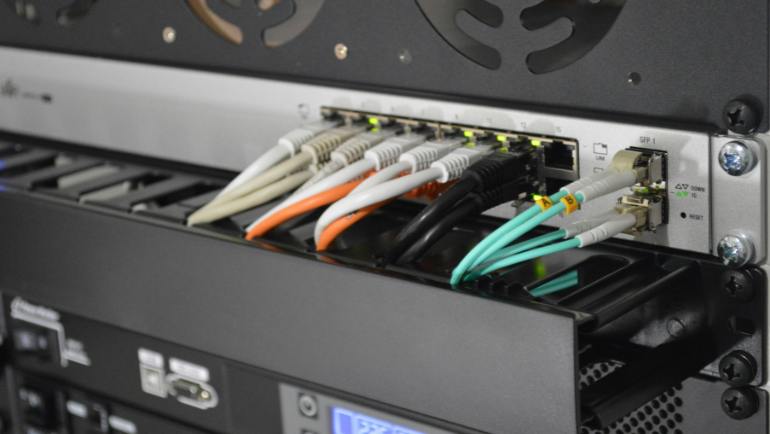
All computer networks require network switches to connect different devices for effective communication. Layer 3 switches are one of the many network switches, allowing enterprises to benefit from both routing and switching functionality. It is a necessary requirement to counter bottlenecks and performance issues in large-scale networks. In this article, we will discuss layer 3 switch definition, types, architecture, and working in detail.
What is a Layer 3 Switch?

Layer 3 switches were introduced in the 2000s with IPV4 routing to route internet traffic faster than routers. It is a combination of both routers and switches and uses the 3rd and 2nd OSI model Layers for communication. Layer 3 switches are commonly referred to as multilayer switches, as it has the functionality of layer 2 switches and the routing capabilities of layer 3 routers. A Layer 3 switch routes data packets by IP or MAC addresses and makes intelligent routing decisions.
Switching capabilities connect devices on the same subnet or VLAN (Virtual Local Area Network), and similar to a router inspects incoming data packets. Many routing protocols are used in 3 Layer switches including (Routing Information Protocol) RIP, (Open Shortest Path First) OSPF, and (Enhanced Interior Gateway Routing Protocol) EIGRP. It’s important to note that layer 3 managed switches are specifically designed for intranet (private) networks as they have only LAN ports.
Layer 3 Switch Architecture
Layer 3 switches use hardware-based switching to achieve higher packet processing rates than routers. It consists of the which are major architectural parts, similar to gigabyte routers. Let’s discuss them briefly below. Layer 3 switches architectural design is similar to routers, but differs in packet processing rates due to hardware base switching.
The architecture has 4 major parts: control plane, data plane, backplane, and physical interfaces. This section breaks down all of them briefly.
- Control Plane: routing and management function of network traffic
- Data Plane: work with data forwarding functions
- Backplane: supports shared bus, memory, and crossbar mode for data transfer
- Physical interface: Send and receive data frames with other hardware using SFP and SFP+ transceivers and RJ-45
How Does Layer 3 Switching Work?
The Layer 3 switch works in two forms: cut-through and Packet-by-Packet Layer 3 switching. Cut-through switches: It determine the first data packet’s IP address and then forwards the reminder packets using the MAC address. This allows enterprises to receive higher throughput rates and lower latency. Packet-by-Packet Layer 3 (PPL3): Functions as high-speed routers, aside from forwarding data packets using IP addressing it performs other functions. PPL3 verifies the packet’s integrity, updates its Time to Live (TTL) after each hop, and processes other information in the same packet. Besides Layer 3 switching functions, it can also perform bridging at each switch interface, allowing enterprises to allocate bandwidth in various ways. This makes layer 3 managed switches a flexible and scalable high-speed network switch for large-scale networks in enterprises.
Purpose of Layer 3 Switches
To improve routing performance on large-scale networks 3 layer switch was introduced. Its primary purpose was to replace layer 2 switches prone to crash during rush hour. Enterprises countered this problem by adding routers with layer 2 switches into the computer network. However, a router can’t function inside layer 2 and requires conversion of data packets from layer 2 to layer 3, causing network latency. Layer 3 switching is a solution that can access both layer 2 and layer 3 OSI models and process layer 2 data packets directly without conversion. It has the speed of a switch and the intelligence of a router, making it perfect for large-scale networks.
Types of Layer 3 Network Switches

Layer 3 managed switches differ from other switches or hubs based on the switching method and interface type it supports. Mentioned below are the classifications of layer 3 switches based on performance, interface, and switching method.
Layer 3 Switches Type Based on Switching Method
As discussed above layer 3 switching operates at the network layer of the OSI model. Several layer 3 switching technologies are used in modern networks, some are as follows:
- Route Caching: Uses a cache to store frequently used routes. It allows switches to route packets if there is a matching route, eliminating the need for a routing table lookup. This type of switching method requires frequent updates of cache memory.
- Topology-based Switching: it builds a network topology map to determine the best path for forwarding data packets. It is efficient but requires complex configuration and management.
- Policy-Based Routing: determines policies to decide the packet path. It helps route data packets from a specific source to a particular destination, mostly used to implement Quality of Service (QoS) and security policies.
- Multi-Layer Switching: It combines layer 2 and 3 routing protocols in a single device and improves network performance by reducing the router loads.
- VLAN Routing: Allows communication between multiple VLANs by routing data packets. It is used to improve network security and simplify network management.
Layer 3 Switches Type Based on Interface
The networking interface forwards IP packets toward the final destination. 3 Layer switches use multiple interfaces such as Switch Virtual Interface (SVI), Router Port and Layer 3 EtherChannel let’s look into them one by one.
- SVI: Routes data packets between 2 VLANs connected to a switch by assigning an IP address to VLANs associated with SVI without a router. It supports both routing and switching protocols.
- Routed Port: A physical port on a switch that acts like a port on a router, supporting routing protocols. However, it is not associated with VLAN nor supports its subinterfaces, but is configured directly on the router.
- Layer 3 EtherChannels: bundles layer 3 ethernet links between network devices to aggregate bandwidth, mostly on up links.
Layer 3 Switches Type Based on Performance
According to the performance of layer 3 managed switches in an enterprise environment. They are divided into the following types.
- High-end Layer 3 Switches: A combination of routing engines, switching fabric, line card models, and more. It offers a three-layer redundancy structure and is normally used in data centers for enterprise applications.
- Midrange Layer 3 Switches: Come in two types: box-type or frame-type switches having 4 slots for aggregating enterprise core and access switches.
- Low-End Layer 3 Switches: Refer to as box-type or desktop switch. It is used as an access switch for IP phones or wireless LAN in enterprises, usually with 24 or 48 ports.
Ways to Configure Layer 3 Network Switch
Two ways of Configuring Layer 3 Swtiches: Physically and Logically.
Logical Layer 3 VLAN
Logical layer 3 VLAN interfaces require configuring and creating the VLANs on the switch. Then, assign VLAN membership to layer 2 interfaces, enable IP routing, and specify its protocols. Follow the steps to configure the Logical layer in 3 layer switches
- Step 1: Create VLAN
- Step 2: Select the interface
- Step 3: Configure IP address and IP subnet
- Step 4: Enable Interface
- Step 5: Save configuration change to NVRAM
- Step 6: Verifies the configuration
Physical Layer 3 VLAN
Setting up physical configuration enables IP routing and specifies its protocols only. To configure the physical layer 3 network switch interface, perform this task:
- Step 1: Select the interface to configure
- Step 2: Convert physical layer 2 to physical layer 3 port
- Step 3: Configure IP address and IP subnet
- Step 4: Enable Interface
- Step 5: Save configuration changes to NVRAM
- Step 6: Verifies the configuration
Layer 3 Switch Features
The following section will highlight some features of Layer 3 network switches in enterprises.
- OSI Model: Performance on layer 2 and layer 3 of OSI model
- Multi-Port Configuration: It usually comes in 24 or 48 ethernet port models which don’t include a WAN interface
- Simple Working: Both the switching algorithm and routing protocols are simple in 3 layer switches for better management
- Security features: Similar to routers, they come equipped with security protocols like loopback detection to protect from hacks and unauthorized access
- Dual Routing: Layer 3 switches incorporate static and dynamic routing, allowing a single switch to support multiple VLANs and optimal packet routing
The Need for Layer 3 Switch
Enterprises and Businesses need layer 3 switches to make faster inter-VLAN routing. As layer 2 switches and routers created bottlenecks in handling larger network traffic the need for better and faster solutions became paramount. Layer 3 switch allows multiple connections between each VLAN without requiring a router as it has all the routing capabilities. This reduces reliance on external routers and enhances the speed and responsiveness of the network. Network segmentation into multiple subnets in 3 layer switches offers scalability and flexibility in network expansion.
Benefits of Layer 3 Switches
Enterprises have various benefits of managed switches, some are as follows.
- Routing Capabilities: Processes Packets faster than traditional routers due to intelligent routing decisions based on IP address. It directs the traffic across different business networks at faster speeds and reduces latency.
- Network Segmentation: Breaks network into segments, prioritizes and manages traffic based on preset parameters. It helps to manage bandwidth, reduce overall network bottlenecks, and prioritize important devices.
- Network Management: It centralizes both switching and routing functions to simplify network configuration, troubleshooting, and maintenance for enterprise networks. Also, integrates with IP networks to replace routers in certain network structures.
Drawbacks of Layer 3 Switches
Let’s look into some of the cons of layer 3 network switches.
- Cost: More expensive than a traditional layer 2 switch due to additional resources like cables, making it costly and complex.
- Limited Applications: Only useful in large-scale networks due to its complex network infrastructure. However, it can be configured to work in smaller networks, but it’s not recommended.
- No WAN capabilities: Layer 3 switch is not a replacement for routers due to the lack of WAN ports. To route traffic from within or outside the organization both layer 3 switches and routers will be required.
Future of Layer 3 Switch

Layer 3 managed switches are expected to innovate and adapt to growing networking demands. Better simplified management, enhanced security, and improvement in IoT management are expected. Software-Define Networking SDN integration will likely improve centralized management, and integrated firewalls like intrusion detection, preventing unauthorized access. This will allow enterprises to further benefit from 3 layer switches in different computer networks and IoT applications.
Best Layer 3 Switches
It’s important to select switches that optimize your network infrastructure speed and performance. Layer 3 network switches help improve large-scale network performance than their counterparts. However, choosing one with the best quality and standard is crucial as many mediocre switches may fail unexpectedly. Normally a good quality layer 3 switch price ranges from anywhere between $90 to $24,990. It may vary depending on model, size, quality, and add-ons. Computing Worlds offers you the best deals and discounts on switches for sale and their accessories.
Best Layer 3 Switches for Sale
You can get a free bulk quote on the required layer 3 switches.
Frequently Ask Questions:
Are Layer 3 Switches Managed?
Yes, layer 3 switches are managed switches.
Can a Layer 3 Switch Replace a Router?
No, Layer 3 managed switches don’t replace routers. Both routers and switches are used in VLAN routing.
Which Router Brands is the Best for Layer 3 Switches?
TP-link and Netgear routers are famous for upholding their quality standard in enterprise networks.
This marks the end of layer 3 switches. Enterprises opt for other networking devices with 3-layer switches to better optimize their network infrastructure. For example: Many devices with AES encryption protect your routers and gateways from external threats. In contrast, you can follow easy tips and tricks to secure your wireless routers without spending on newer equipment. However, if you encounter any problem during configurations troubleshooting the router may fix the problem.
For more information about switches stay connected to the Computing Worlds blog.






